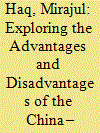| Srl | Item |
| 1 |
ID:
180637


|
|
|
|
|
| Summary/Abstract |
This paper explores whether the China–Pakistan Free Trade Agreement (FTA), which entered into effect in 2007, has led to advantages or disadvantages for the participating countries. It assesses the gains and losses associated with the agreement rigorously using two different approaches. First, the revealed comparative advantage index is calculated for 10 commodity groups. This identifies the commodity groups in which the participating countries have a comparative advantage. Second, trade creation and trade diversion are estimated for overall imports and for the commodity-group level imports. This analysis provides useful information about the commodity groups in which a particular party to the FTA is experiencing an advantage or a disadvantage. The findings of the study show that China has an advantage in producing capital-intensive goods whereas Pakistan has a comparative advantage in the production of primary and semimanufactured goods. The empirical findings also indicate that, overall, the formation of the bilateral free trade agreement between Pakistan and China enhances trade with member countries as well as with nonparticipating countries.
|
|
|
|
|
|
|
|
|
|
|
|
|
|
|
|
| 2 |
ID:
133193


|
|
|
|
|
| Publication |
2014.
|
| Summary/Abstract |
This study uses a theoretically justified gravity model of trade to examine the impact of the ASEAN-China Free Trade Agreement (ACFTA) on exports, focusing on trade creation and diversion effects. The model is tested on a sample of 31 countries over the period dating from 1995 to 2010 using aggregated and disaggregated export data for agricultural and manufactured goods and within manufactures for chemical products, as well as for machinery and transport equipment. In order to obtain unbiased estimates, multilateral resistance terms are included as regressors and the endogeneity bias of the FTA variables is addressed by controlling for the unobserved specific heterogeneity that is specific to each trade flow. A multinomial PML is also applied to solve the zero trade issue and the presence of heteroskedasticity. The results indicate that ACFTA leads to substantial and significant trade creation. Using disaggregated data, the significant and positive relationship between exports and ACFTA is confirmed in the case of both agricultural and manufactured goods, as well as in the case of the most important manufacturing industries, namely, chemical products and machinery and transport equipment.
|
|
|
|
|
|
|
|
|
|
|
|
|
|
|
|
| 3 |
ID:
165372


|
|
|
|
|
| Summary/Abstract |
The present study endeavours to observe the trade creation and trade diversion effects of three free trade agreements (FTAs) in Asia, namely, India–Japan CEPA (IJCEPA), India–Sri Lanka FTA (ISFTA), and India–Bhutan FTA (IBFTA). The article aims to evaluate three uncommon FTAs that include developing–developed, developing–developing and developing–least developed countries. The objective is to evaluate the effects of these FTAs on exports and draw lessons for both the contracting parties and for other economies to commence FTAs that promote trade liberalization. This paper also aims to debunk the myth that FTAs between developing-least developed countries is not beneficial for the developing or least developed counterpart. The study applies augmented gravity model to capture the trade creation and trade diversion effects. The results confirm that ISFTA and IBFTA have trade creation effect, while in case of IJCEPA, there is trade diversion. These bilateral agreements can open the ways for multilateral trade liberalization in the long-run.
|
|
|
|
|
|
|
|
|
|
|
|
|
|
|
|